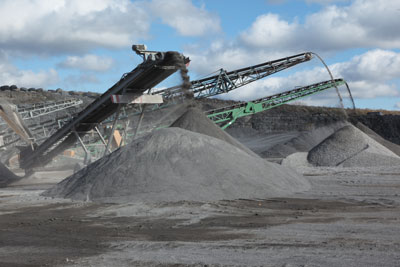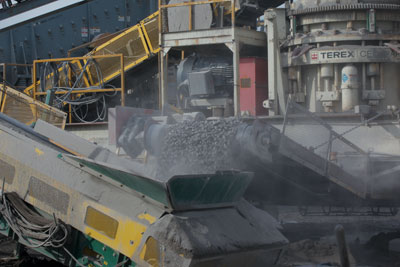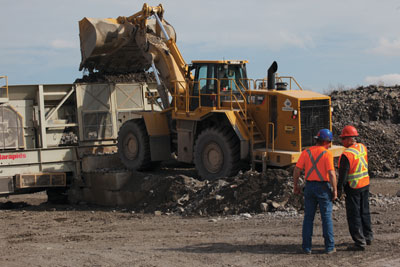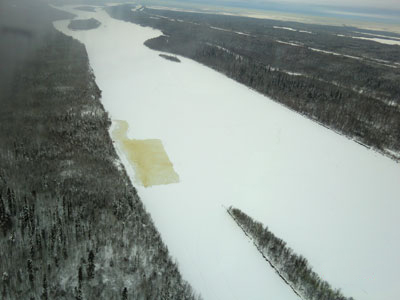
Features
Aggregates
Profiles
Cruickshank Construction
This large eastern Ontario aggregate producer and roadbuilder puts employee engagement at the top of
April 17, 2012 By Treena Hein
It was during 2007 that Kingston-based roadbuilding company and
aggregate producer Cruickshank Construction began seeking feedback from
its employees
It was during 2007 that Kingston-based roadbuilding company and aggregate producer Cruickshank Construction began seeking feedback from its employees – beginning a journey that has made things better for everyone at the company, and for the company itself.
 |
|
| Cruickshank handles about 1.2 million tonnes of limestone per year.
|
“We did a survey with an outside consultant because we wanted to find out how we could better meet the needs of our workers,” says CEO Steve Cruickshank. “It was clear they wanted a pension plan and other things that didn’t yet exist and we took action.”
It was the start of an engaging dialogue that quickly led to the creation of a human resources department in 2008. “We have about 700 employees – between 400 and 500 year-round – and it made sense,” Cruickshank says. “Workers were asking their supervisors HR-related things and they were just too busy to try and get answers back to them in a timely fashion.”
The HR department and company executives went further by creating WIN, Cruickshank’s Workers Input Network, to seek ongoing feedback. “Employees have since asked for things like performance appraisals and options for career advancement, and we’ve put those into place,” says HR manager Lisa Anderson. “It’s created much more opportunity to promote from within and led to things like our long-term disability program and supervisory training program. And now, by employee request, we’re going to institute appraisal of management. It all helps keep our workers’ job satisfaction and productivity higher.”
This interest in employee engagement has landed Cruickshank on the ‘Top 50 Best Small and Medium Employers in Canada’ list two years running. “We were 41 two years ago and then 27 last year, and this year’s goal is to be in the top 20,” says Cruickshank. The company has also been named one of Canada’s most environmentally conscious companies (The Green 30) by Maclean’s magazine.
Cruickshank is proud that many families have been with the company for over three generations. “Our customers regularly praise our teams, their level of expertise and their professional approach to each project,” he notes. “My father calls them ‘the envy of the industry’ and it’s really true. We have the kinds of people who will do a great job no matter what challenges are thrown at them.”
History
The Cruickshank story began in 1954, when Steve’s father Les Cruickshank was asked to travel to Peru to do some drilling and blasting for six months. “He came home and used his savings to buy his first grader,” Steve explains. “He then helped to build the St. Lawrence Seaway and grew the company from there.”
 |
|
| Most of the quarries are owned by Cruickshank, and the wide variety of granular products are used for roadbuilding.
|
In 2000, Les officially passed on ownership to Steve, who continued to seek out new opportunities for growth – and tripled the company’s size. Cruickshank’s operations include highway construction and maintenance, aggregate, asphalt, and concrete production, asphalt recycling and real estate holdings.
The company’s operations extend across Ontario, and include three regional offices, 16 limestone quarries, four gravel/sand pits and a specialized red granite quarry (they are developing a market for things like concrete pre-cast and landscaping products). Most of the quarries are owned by Cruickshank, and the wide variety of granular products are used for roadbuilding, as aggregate in their CMC low-profile concrete batch plant and for asphalt production (two plants; Stansteel and Barber Greene). They also sell some aggregates to other contractors and municipal customers. Three quarries are kept open all winter. Cruickshank handles about 1.2 million tonnes of limestone per year and has about 75 million tonnes in reserve.
All of the company’s crushing is carried out using portable crushing plants to best service the many locations. Cruickshank uses a Cedar Rapids spread (purchased in 2008) to handle the harder stone found at some of the quarries. A 988H CAT feeds the Cedar Rapids 3054 primary crusher, which produces 6 inch minus product. A surge feeder provides consistent flow to MVP 450 Cedar Rapids cone. Finished product moves through the Eljay 6 x 20 screen, and onto a Superior Radial telescopic stacker. In addition to other product stackers, a 972H CAT assists with stockpiling and truck loading. A second spread includes a Cedar Rapids 3645 impellor primary with a Cedar Rapids 5064 double impellor secondary and fed by one or two 980H CAT loaders. Recent addition of a JSI Kodiak 300 cone assists with sizing asphalt coarse aggregate. An inclined 6 x 20 Simplicity screen completes the product separation and onto radial stackers assisted by 966H or 980H CAT loaders.
“We also have a drilling and blasting unit of up to 10 to 12 people for our own quarries, but they also handle two regular quarry customer contracts and a few other occasional ones,” says president and chief operations officer Dave Read. Highway maintenance is another significant company focus. “Two main contracts for the Ministry of Transportation (MTO) are year-round road maintenance contracts,” Read notes, “including 750 km of two-lane highway in the Belleville/Port Hope/Bancroft area plus 180 km of two-lane highway subcontract east of Oshawa.”
Their snow removal contracts, for the MTO and cities such as Cornwall, Kingston and Toronto, involve over 100 trucks.
In the United States, Cruickshank has a shuttlebuggy rental service, and in Lac La Biche, Alta. (located between Edmonton and Fort McMurray, an area being developed for steam-assisted gravity draining oil extraction), they rent heavy equipment as well – in addition to building winter access roads and ice drilling pads.
“Making the winter roads involves using snow-makers to cover stream crossings, and driving frost into the ground to get deep freezing,” says Read. “This winter, we are contracted to build over 170 km of access road servicing over 400 drilling sites. Last year we built a drilling pad on the Athabasca River the size of an NHL skating rink using water pumped from the river.”
Environmental action
Cruickshank has many initiatives in place to lessen the environmental impact of its operations. “We’ve performed energy audits at several key facilities and we have a pilot project running where a scale house is using only solar power,” notes Cruickshank. “We may expand that. There are so many opportunities to go green.” The company has done lighting retrofits at 11 offices, and upgraded insulation at one of its asphalt plants. Management encourages the use of public transit and carpooling, and use video- and tele-conferencing and paperless office processes as much as possible. All suitable paper, metals, batteries, and waste oils are recycled.
 |
|
| Operations extend across Ontario, and include three regional offices, 16 limestone quarries, four gravel/sand pits and a specialized red granite quarry.
|
The company has also upgraded its heavy equipment fleet with more fuel-efficient models. All operators minimize or eliminate idling, and the GPS monitoring systems on some pieces of equipment also helps monitor performance. Equipment with higher fuel consumption is identified, and maintenance is performed to correct the issue. In its winter road maintenance, Cruickshank uses software to more effectively apply salt and sand, and also uses other de-icing substances to minimize salting where practical.
A couple of years ago, the company purchased a cold-in-place recycling train (Roadtec), which allows one-pass recycling of asphalt pavement. “It gives us outstanding results,” says Cruickshank. “It reduces fuel usage by 80 per cent and cuts greenhouse gases by half over traditional methods. It also significantly reduces traffic delays. It’s integral to our operation.”
This past summer, Cruickshank was certified in both ISO:9001 and ISO:14001 for their highway maintenance operations. As well, the company maintains appointments on industry boards and committees such as ORBA (Ontario Road Builders Association), OHMPA (Ontario Hot Mix Paving Association) and OSSGA (Ontario Stone, Sand, and Gravel Association).
Company atmosphere
One of the many ways Cruickshank creates a positive workplace is the company newsletter, Pick & Shovel. “It’s been going for 25 years and is currently professionally produced six times per year,” says Cruickshank. “It features stories about the projects we’re working on and individual employee and department profiles, company news, human resources updates and a community bulletin board.”
 |
|
| Drilling platform on the Athabasca River.
|
The website has recently been updated and now includes an employee portal where employees can log in and view essential information. The company also recognizes years served (members of The Cruickshank Club have worked there 20 years or more). Les, Steve, Dave Read and Lisa Anderson personally serve a steak meal with all the fixings to everyone in the company (at various sites) once a year at their Roadkill Café barbeques. “They’re basically open houses for our crews and nearby residents,” says Cruickshank. “We have a good relationship with our neighbours. Nearby residents can walk in anytime to see the supervisor if they have an issue or question. People are starting to understand that local aggregate sources make environmental sense.”
Cruickshank proudly gives back to the many communities where employees live and work. Employees are proud of the corporate donation record, and are directly involved in selecting funding recipients. Safety is also very important. “We initiated the use of green hardhats for new employees and people visiting our worksites,” says Cruickshank, “and this is working very well. It identifies them and reminds others to go the extra mile to explain things and go over procedures with them because they’re new. Our people are everything.”
When asked about future goals, everyone is in agreement. “We want to be a great place to work, and grow the business,” Cruickshank notes, “while also instituting new programs and processes that will help us serve our employees and our customers better.”
Print this page